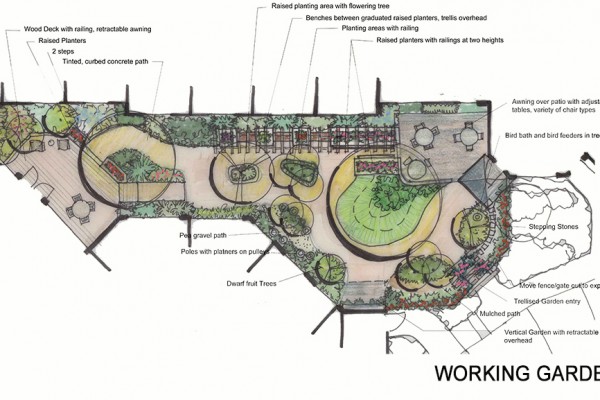Recent research indicates that confidence in the ability to perform a task related to a therapy program can result in higher patient motivation and better outcomes.1 Furthermore, if the task is one that is meaningful and suited to the patient it can influence behavior in choice, amount of effort and persistence.2
“Gardening is one of the most popular home-based activities in the United states and has been reported as the second most common leisure activity, after walking , of adults older than age 65.”3 Gardening and walking outdoors are activities that have the potential to motivate therapy participants because they are meaningful and pleasurable. Additionally, through carefully designed outdoor environments, therapy programs that include gardening and walking outdoors can be structured to match patients’ capabilities, tapping into their confidence to perform tasks within the program.
Belief in a personal capacity to adapt and maintain skills is critical. Without this belief effort will be withdrawn and recovery less successful. Therapy programs that are structured to successively increase performance accomplishments promote a sense of personal responsibility for those accomplishments and may supply confidence for better outcomes throughout the program.1 A study by Mooney and Nicell (1992) showed that horticultural activities are especially suited to older adults as they can easily be adapted to a variety of skill levels.4 A variety of graded, reality based outdoor walking experiences can be presented in a garden as well to improve ambulatory skills and encourage exercise.
Beyond being meaningful activities that are easily adaptable to a variety of skill levels, a large body of research shows additional benefits associated with being outdoors gardening or walking. (We have explored these benefits in earlier emails. Please let us know if you would like to receive these articles again). These benefits which may include reducing falls, the risk of dementia and symptoms of depression can represent substantial reductions in the cost of care, 5 and if used in structured therapy programs can replicate billable indoor therapy activities.
Contact Studio Sprout today for a menu of design services that will integrate outdoor areas for well being into your campus and therapy program.
2 Wu C, Wong M, Lin K, Chen H. (2001) Effects of task goal and personal preference on seated reaching kinematics after stroke. Stroke, 32:70-76 DOI: 10.1161/01.STR.32.1.70
3 Nauert R. (2011) Seniors who dig gardening report better quality of life. Retrieved August 8, 2012 from central.com/news/2011/03/21/seniors-who-dig-gardening-reort-better-quality-of-life/24520.html
4 Jarrot S, Kwack H, Relf D. (2002) An observational assessment of a Dementia-specific horticultural therapy program. Hortechnology July-September 2002 12(3)
5 Gillespie LD, Gillespie WJ, Robertson MC, Lamb SE, Cumming RG, Rowe BH. (2003). Interventions for preventing falls in elderly people. Cochrane Database of Systematic Review Issue 4. Art. No.: CD000340. DOI:10.1002/146551858.CD0000340.


